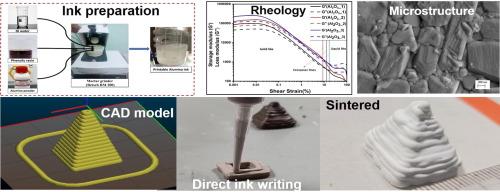Structure-property correlation of alumina pyramidoids fabricated by direct ink writing
IF 2
Q3 ENGINEERING, MANUFACTURING
引用次数: 0
Abstract
The direct ink writing (DIW) technique prints alumina Pyramidoids. Ink formulation included the usage of pure alumina powder, phenolic resin, and deionized water. Alumina ink with a solid loading of 64 vol% provides suitable rheological properties for 3D printing. The synthesized ink was used for 3D printing of a pyramidoid and sintering at different temperatures (1500 °C–1600 °C). The sample sintered at 1600 °C exhibits a dense microstructure (98 %), good flexural strength (308.34 ± 10 MPa), moderate fracture toughness (4.01 ± 0.4 MPa.m1/2), and high hardness (1625 HV).

直接墨水书写法制备氧化铝锥体的结构-性能关系
直接墨水书写(DIW)技术打印氧化铝金字塔。油墨配方包括使用纯氧化铝粉、酚醛树脂和去离子水。固体负载为64 vol%的氧化铝墨水为3D打印提供了合适的流变特性。将合成的油墨用于金字塔体的3D打印,并在不同温度(1500℃- 1600℃)下烧结。1600℃烧结后的试样组织致密(98%),具有良好的抗弯强度(308.34±10 MPa)和中等的断裂韧性(4.01±0.4 MPa)。m1/2),高硬度(1625hv)。
本文章由计算机程序翻译,如有差异,请以英文原文为准。
求助全文
约1分钟内获得全文
求助全文
来源期刊

Manufacturing Letters
Engineering-Industrial and Manufacturing Engineering
CiteScore
4.20
自引率
5.10%
发文量
192
审稿时长
60 days
 求助内容:
求助内容: 应助结果提醒方式:
应助结果提醒方式:


